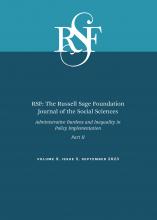Research Article
Open Access
Administrative Burdens and Economic Insecurity Among Black, Latino, and White Families
Zachary Parolin, Christina J. Cross, Rourke O’Brien
RSF: The Russell Sage Foundation Journal of the Social Sciences September 2023, 9 (5) 56-75; DOI: https://doi.org/10.7758/RSF.2023.9.5.03
Zachary Parolin
aAssistant professor of social policy at Bocconi University in Milan, Italy
Christina J. Cross
bAssistant professor of sociology at Harvard University, United States
Rourke O’Brien
cAssistant professor of sociology at Yale University, United States

REFERENCES
- ↵
- Bitler, Marianne,
- Hilary Hoynes, and
- Elira Kuka
- ↵
- Carey, Patrick,
- Jeffrey A. Groen,
- Bradley A. Jensen,
- Thomas J. Krolik, and
- Anne E. Polivka
- ↵
- Center on Budget and Policy Priorities
- ↵
- Coady, David,
- Samir Jahan,
- Riki Matsumoto, and
- Baoping Shang
- ↵
- Couch, Kenneth A.,
- Nicholas A. Jolly, and
- Dana W. Placzek
- ↵
- Couch, Kenneth A., and
- Dana W. Placzek
- ↵
- Cross, Christina J
- ↵
- D.C. Department of Human Services
- ↵
- ↵
- East, Chloe, and
- David Simon
- ↵
- e-Estonia
- ↵
- Elder, Todd, and
- Elizabeth Powers
- ↵
- Falk, Gene
- ↵
- Falk, Gene,
- Paul D. Romero,
- Issac A. Nicchitta, and
- Emma C. Nyhof
- ↵
- Figinski, Theodore
- ↵
- Flood, Sarah,
- Miriam King,
- Renae Rodgers,
- Steven Ruggles,
- J. Robert Warren, and
- Michael Westberry
- ↵
- Floyd, Ife,
- Ladonna Pavetti,
- Laura Meyer,
- Ali Safawi, and
- Liz Schott
- ↵
- Friedman, Abigail S., and
- Atheendar S. Venkararamani
- ↵
- Gabe, Thomas, and
- Julie Whittaker
- ↵
- Gould-Werth, Alix, and
- H. Luke Schaefer
- ↵
- Hardy, Bradley, and
- Trevon Logan
- ↵
- Hardy, Bradley,
- Timothy Smeeding, and
- James P. Ziliak
- ↵
- ↵
- Helmes
- ↵
- Herd, Pamela
- ↵
- ↵
- Herd, Pamela, and
- Donald P. Moynihan
- ↵
- Hoynes, Hilary W., and
- Diane Whitmore Schanzenbach
- ↵
- Hoynes, Hilary W.,
- Diane Whitmore Schanzenbach, and
- Douglas Almond
- ↵
- Kroft, Kory
- ↵
- Kuka, Elira, and
- Bryan A. Stuart
- ↵
- Lacoma, Tyler
- ↵
- Lundberg, Ian
- ↵
- Michener, Jamila
- ↵
- ↵
- National Academies of Sciences, Engineering, and Medicine
- ↵
- Nichols, Austin, and
- Margaret Simms
- ↵
- Nisar, Muhammad Azfar
- ↵
- O’Brien, Rourke,
- Tiffany Neman,
- Nathan Seltzer,
- Linnea Evans, and
- Atheendar Venkataramani
- ↵
- Parolin, Zachary
- ↵
- Rothstein, Jesse, and
- Robert G. Valletta
- ↵
- Shapiro, Isaac, and
- Danilo Trisi
- ↵
- Shrider, Emily A.,
- Melissa Kolar,
- Frances Chen, and
- Jessica Semega
- ↵
- Skandalis, Daphné,
- Ioana Marinescu, and
- Maxim Massenkoff
- ↵
- Sommers, Ben,
- Rick Kronick,
- Kenneth Finegold,
- Rosa Po,
- Karyn Schwartz, and
- Sherry Glied
- ↵
- Soss, Joe,
- Richard Fording, and
- Sanford Schram
- ↵
- Stevens, Kathryn,
- Liana E. Fox, and
- Misty L. Heggeness
- ↵
- Thévenot, Celine,
- Virginia Maestri,
- Isabelle Maquet
- ↵
- Vroman, Wayne
- ↵
- Wandner, Stephen A., and
- Andrew Stettner
- ↵
- Wang, Julia Shu-Huah
- ↵
- Watson, Tara
- ↵
- Wheaton, Laura, and
- Victoria Tran
- ↵
- U.S. Department of Health and Human Services
In this issue
Administrative Burdens and Economic Insecurity Among Black, Latino, and White Families
Zachary Parolin, Christina J. Cross, Rourke O’Brien
RSF: The Russell Sage Foundation Journal of the Social Sciences Sep 2023, 9 (5) 56-75; DOI: 10.7758/RSF.2023.9.5.03
Jump to section
Related Articles
- No related articles found.
Cited By...
- No citing articles found.





